Dissemination and evolution of SARS-CoV-2 in the early pandemic phase in South America
- PMID: 33764553
- PMCID: PMC8250755
- DOI: 10.1002/jmv.26967
Dissemination and evolution of SARS-CoV-2 in the early pandemic phase in South America
Abstract
Severe acute respiratory syndrome coronavirus-2 (SARS-CoV-2) pandemic spread rapidly and this scenario is concerning in South America, mainly in Brazil with more than seven million cases of infection. Three major pandemic lineages/clades could be identified along with SARS-CoV-2 dissemination (G, GR, and GH) in the Americas. These clades differ according to their genomic characteristics, virulence, and spreading times. The present study describes the main clades and the respective temporal spreading analyses based on SARS-CoV-2 whole-genome sequences (WGS) from South America, obtained in the early pandemic phase (from March 1 to May 31 in 2020). SARS-CoV-2 WGSs with available information from country and year of sampling were obtained from different countries and the main clades were identified and analyzed independently with a Bayesian approach. The results demonstrated the prevalence of clades GR (n = 842; 54.6%), G (n = 529; 34.3%), and GH (n = 171; 11.1%). The frequencies of the clades were significantly different between South American countries. Clade G was the most prevalent in Ecuador, Suriname, and Uruguay, clade GR in Argentina, Brazil, and Peru, and clade GH in Colombia. The phylodynamic analysis indicated that all these main lineages increased viral spreading from February to early March and after an evolutionary stationary phase was observed. The decrease observed in the virus dissemination was directly associated to the reduction of social movement after March. In conclusion, these data demonstrated the current predominance of clades G, GR, and GH in South America because of the early dissemination of them in the first pandemic phase in South America.
Keywords: SARS coronavirus; dissemination; pandemic.
© 2021 Wiley Periodicals LLC.
Conflict of interest statement
The authors declare that htere are no conflicts of interests.
Figures

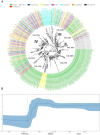
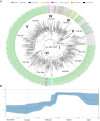
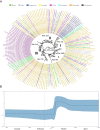
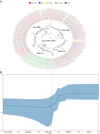
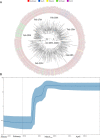
Similar articles
-
Temporal spread and evolution of SARS-CoV-2 in the second pandemic wave in Brazil.J Med Virol. 2022 Mar;94(3):926-936. doi: 10.1002/jmv.27371. Epub 2021 Oct 8. J Med Virol. 2022. PMID: 34596904 Free PMC article.
-
A Founder Effect Led Early SARS-CoV-2 Transmission in Spain.J Virol. 2021 Jan 13;95(3):e01583-20. doi: 10.1128/JVI.01583-20. Print 2021 Jan 13. J Virol. 2021. PMID: 33127745 Free PMC article.
-
Molecular evolution of SARS-CoV-2 from December 2019 to August 2022.J Med Virol. 2023 Jan;95(1):e28366. doi: 10.1002/jmv.28366. J Med Virol. 2023. PMID: 36458547 Free PMC article. Review.
-
Phylogenomics reveals multiple introductions and early spread of SARS-CoV-2 into Peru.J Med Virol. 2021 Oct;93(10):5961-5968. doi: 10.1002/jmv.27167. Epub 2021 Jul 16. J Med Virol. 2021. PMID: 34185310 Free PMC article.
-
Identification of Novel Candidate Epitopes on SARS-CoV-2 Proteins for South America: A Review of HLA Frequencies by Country.Front Immunol. 2020 Sep 3;11:2008. doi: 10.3389/fimmu.2020.02008. eCollection 2020. Front Immunol. 2020. PMID: 33013857 Free PMC article. Review.
Cited by
-
Temporal spread and evolution of SARS-CoV-2 in the second pandemic wave in Brazil.J Med Virol. 2022 Mar;94(3):926-936. doi: 10.1002/jmv.27371. Epub 2021 Oct 8. J Med Virol. 2022. PMID: 34596904 Free PMC article.
-
Influence of the COVID-19 pandemic on labor and childbirth care practices in Brazil: a cross-sectional study.BMC Pregnancy Childbirth. 2023 Feb 3;23(1):91. doi: 10.1186/s12884-023-05358-2. BMC Pregnancy Childbirth. 2023. PMID: 36732728 Free PMC article.
-
COVID-19 pandemic in Southern Brazil: Hospitalizations, intensive care unit admissions, lethality rates, and length of stay between March 2020 and April 2022.J Med Virol. 2022 Oct;94(10):4839-4849. doi: 10.1002/jmv.27942. Epub 2022 Jun 23. J Med Virol. 2022. PMID: 35711083 Free PMC article.
-
Dominant clade-featured SARS-CoV-2 co-occurring mutations reveal plausible epistasis: An in silico based hypothetical model.J Med Virol. 2022 Mar;94(3):1035-1049. doi: 10.1002/jmv.27416. Epub 2021 Nov 1. J Med Virol. 2022. PMID: 34676891 Free PMC article.
-
Obstetric outcomes in breastfeeding women in the first hour of delivery before and during the COVID-19 pandemic.BMC Pregnancy Childbirth. 2025 Jan 11;25(1):24. doi: 10.1186/s12884-024-06975-1. BMC Pregnancy Childbirth. 2025. PMID: 39799310 Free PMC article.
References
-
- GISAID Initiative. COVID‐19 dashboard by the Center for Systems Science and Engineering (CSSE) at John Hopkins University. 2020. https://gisanddata.maps.arcgis.com/apps/opsdashboard/index.html#/bda7594.... Accessed November 12, 2020.
Publication types
MeSH terms
Grants and funding
LinkOut - more resources
Full Text Sources
Other Literature Sources
Medical
Miscellaneous

